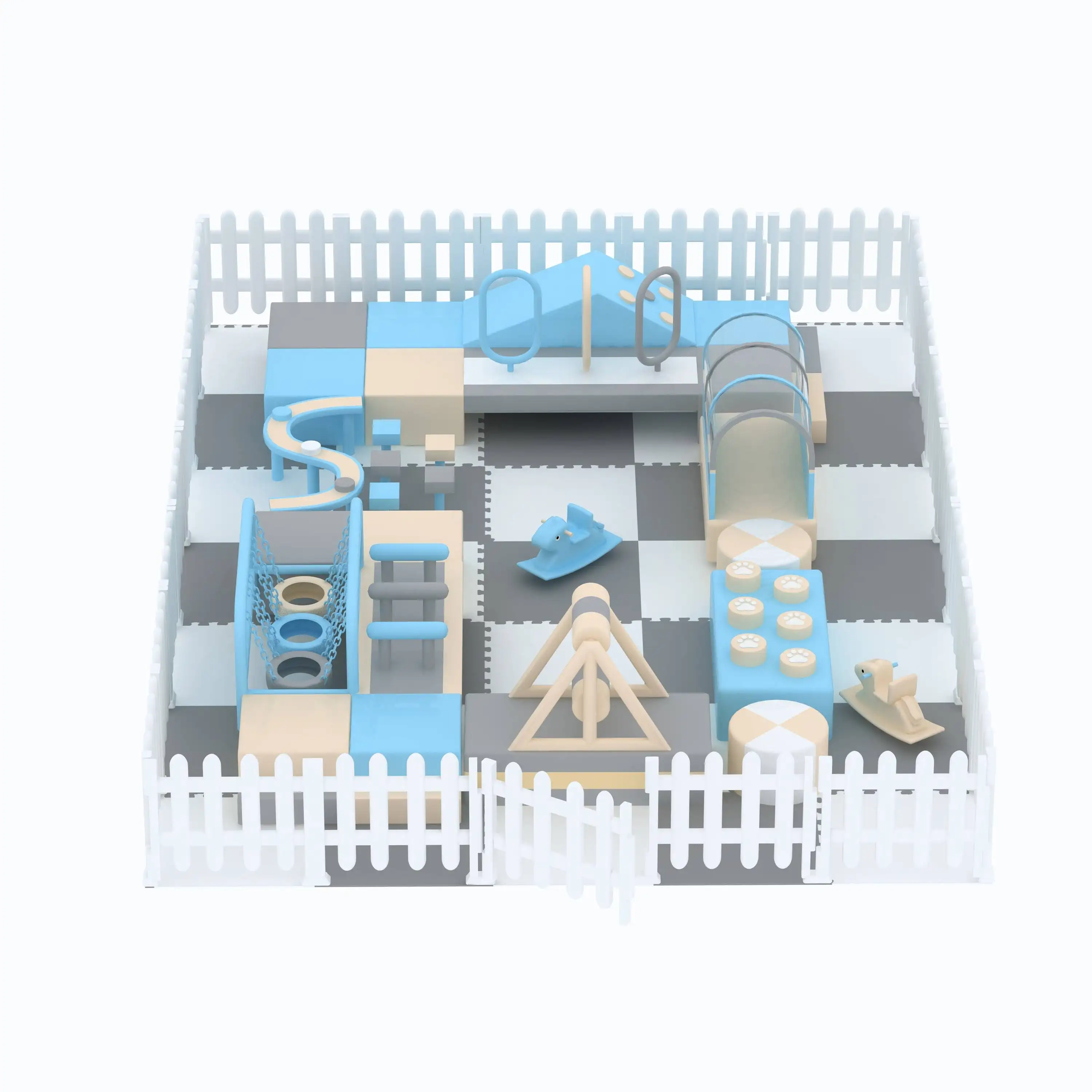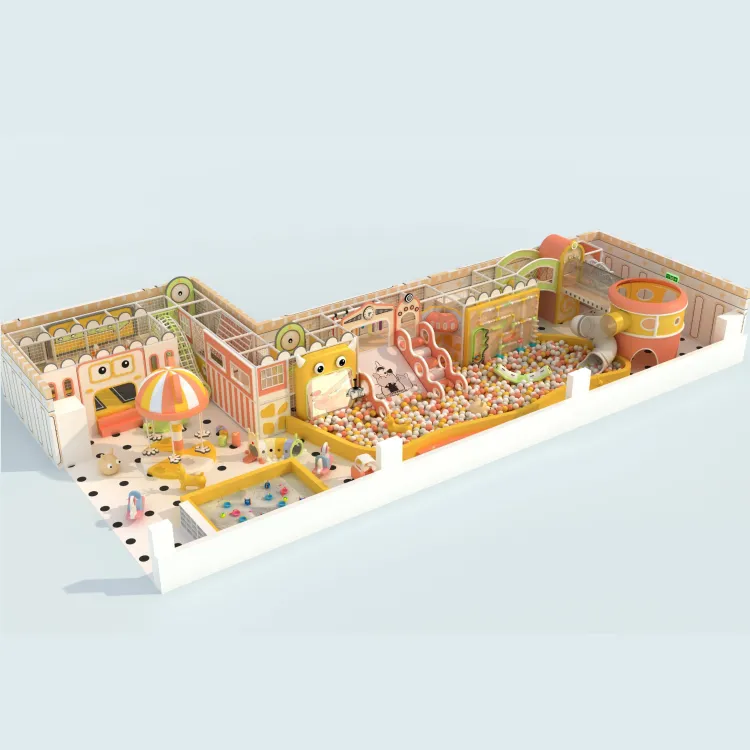การสร้างพื้นที่เล่นรูปแบบทันสมัยที่ดีที่สุดสำหรับเด็ก
สมัยใหม่ สนามเด็กเล่นสำหรับเด็ก ได้พัฒนาไปไกลเกินกว่าชุดอุปกรณ์เล่นแบบโลหะพื้นฐานอย่างเช่น สไลด์เดอร์และชิงช้าในอดีต ปัจจุบันพื้นที่สำหรับการเล่นถูกออกแบบมาอย่างรอบคอบเพื่อส่งเสริมกิจกรรมทางกาย การพัฒนาด้านสติปัญญา และการมีปฏิสัมพันธ์ทางสังคม พร้อมทั้งยังคงรักษามาตรฐานความปลอดภัยสูงสุด เมื่อชุมชนและโรงเรียนต่างลงทุนปรับปรุงสิ่งอำนวยความสะดวกเพื่อการพักผ่อนหย่อนใจ การเข้าใจองค์ประกอบหลักของสนามเด็กเล่นในยุคปัจจุบันจึงมีความสำคัญมากยิ่งขึ้น
นวัตกรรมล่าสุดในการออกแบบสนามเด็กเล่นมุ่งเน้นการสร้างสภาพแวดล้อมที่เปิดกว้างและกระตุ้นพัฒนาการ ซึ่งตอบสนองเด็กทุกวัยและทุกความสามารถ สิ่งเหล่านี้ไม่เพียงแค่ให้ความบันเทิงเท่านั้น แต่ยังทำหน้าที่เป็นเครื่องมือพัฒนาการที่สำคัญ ช่วยส่งเสริมทักษะด้านร่างกาย ทักษะทางสังคม และการคิดสร้างสรรค์ของเด็กๆ
องค์ประกอบหลักของการออกแบบสนามเด็กเล่นในยุคปัจจุบัน
โครงสร้างการเล่นแบบโต้ตอบ
หัวใจสำคัญของสนามเด็กเล่นสำหรับเด็กยุคใหม่คือโครงสร้างการเล่นแบบโต้ตอบ สิ่งอำนวยความสะดวกเหล่านี้ก้าวข้ามอุปกรณ์แบบดั้งเดิม โดยการเพิ่มองค์ประกอบที่ตอบสนองต่อการกระทำของเด็ก เพื่อส่งเสริมการเรียนรู้เชิงเหตุและผล แผงดิจิทัลที่มีเกม เครื่องดนตรี และคุณสมบัติที่ทำงานโดยการตรวจจับการเคลื่อนไหว ช่วยสร้างสภาพแวดล้อมที่น่าสนใจ และเชื่อมโยงการเล่นทางกายภาพกับการมีปฏิสัมพันธ์ทางเทคโนโลยี
โครงสร้างปีนป่ายขั้นสูงที่มีหลายชั้น อุโมงค์ และสะพาน ช่วยเปิดโอกาสให้เด็กได้พัฒนาร่างกายอย่างท้าทายแต่ปลอดภัย โครงสร้างแบบโมดูลาร์เหล่านี้มักมีองค์ประกอบเพื่อการรับรู้ เช่น พื้นผิวที่มีลวดลายต่างๆ และรูปแบบสีสันสดใส ซึ่งกระตุ้นการสำรวจด้วยการสัมผัสและการรับรู้ทางสายตา
นวัตกรรมพื้นสนามที่ปลอดภัย
ในไม่กี่ปีที่ผ่านมา พื้นสนามที่ปลอดภัยได้รับการพัฒนาอย่างน่าประทับใจ ปัจจุบันพื้นสนามเด็กเล่นใช้วัสดุล้ำสมัยที่สามารถดูดซับแรงกระแทกได้ดีเยี่ยม ในขณะเดียวกันก็เป็นมิตรต่อสิ่งแวดล้อม ขุยยาง ยางเทปู หรือเส้นใยไม้วิศวกรรม เป็นตัวเลือกยอดนิยมที่ผ่านมาตรฐานความปลอดภัยอย่างเข้มงวด
พื้นผิวเหล่านี้ไม่เพียงแต่ช่วยปกป้องเด็กจากการตกจากที่สูง แต่ยังเสริมสร้างความสวยงามของสนามเด็กเล่นผ่านสีและลวดลายต่างๆ อีกด้วย การติดตั้งสมัยใหม่จำนวนมากยังรวมเอาองค์ประกอบการเรียนรู้ไว้ในพื้นผิวโดยตรง เช่น เกมตัวเลข ตัวอักษร หรือรูปทรงเรขาคณิต

องค์ประกอบการเล่นที่ได้แรงบันดาลใจจากธรรมชาติ
ลักษณะการปีนป่ายตามธรรมชาติ
สนามเด็กเล่นสำหรับเด็กยุคใหม่เริ่มนำเอาองค์ประกอบจากธรรมชาติเข้ามาใช้มากขึ้น เพื่อสร้างประสบการณ์ปีนป่ายที่ใกล้เคียงกับความเป็นจริง อุปกรณ์ปีนไม้ซุง การติดตั้งหินก้อนใหญ่ และโครงสร้างที่ได้รับแรงบันดาลใจจากต้นไม้ ช่วยส่งเสริมกิจกรรมทางกายที่ท้าทาย ขณะเดียวกันก็ยังคงสร้างความผูกพันกับธรรมชาติ สิ่งเหล่านี้ช่วยให้เด็กพัฒนาทักษะการเคลื่อนไหวของร่างกาย ความสมดุล และการรับรู้ในเชิงพื้นที่ ในสภาพแวดล้อมที่เป็นธรรมชาติมากยิ่งขึ้น
การนำเอาองค์ประกอบจากธรรมชาติมาใช้ยังขยายไปยังภูมิทัศน์โดยรอบ โดยนักออกแบบจะสร้างลักษณะภูมิประเทศที่หลากหลาย เช่น เนินเขาและหุบเขา สิ่งอำนวยความสะดวกเหล่านี้ส่งเสริมให้เด็กวิ่ง เกลือกกลิ้ง และเล่นอย่างมีการสำรวจ พร้อมทั้งเพิ่มความน่าสนใจทางสายตาให้กับสภาพแวดล้อมของสนามเด็กเล่น
สวนเพื่อการรับรู้ทางประสาทสัมผัสและพื้นที่สีเขียว
สนามเด็กเล่นสำหรับเด็กยุคใหม่ที่ได้รับการออกแบบอย่างดีควรรวมถึงพื้นที่สีเขียวเฉพาะที่ทำหน้าที่หลายประการ สวนเพื่อการรับรู้ทางประสาทสัมผัสที่มีพืชพรรณ เนื้อสัมผัส และกลิ่นต่างๆ มากมาย ช่วยเปิดโอกาสในการเรียนรู้ที่มีคุณค่า และเป็นพื้นที่เงียบสงบสำหรับเด็กที่อาจต้องการพักผ่อนจากการเล่นในพื้นที่ที่ต้องใช้พลังงานมากกว่า
พื้นที่ธรรมชาติเหล่านี้มักมีพืชพื้นเมือง สวนผีเสื้อ และสิ่งปลูกสร้างขนาดเล็กที่เกี่ยวกับน้ำ ซึ่งช่วยสอนเด็กๆ เกี่ยวกับระบบนิเวศในท้องถิ่น พร้อมทั้งเปิดโอกาสให้เด็กได้เล่นอย่างมีส่วนร่วม การนำเครื่องดนตรีที่ทนต่อสภาพอากาศและแผงศิลปะมาติดตั้งในพื้นที่เหล่านี้ยังช่วยเสริมประสบการณ์ด้านประสาทสัมผัสได้อีกด้วย
สิ่งอำนวยความสะดวกสำหรับการเล่นแบบรวมทุกคน
การออกแบบอุปกรณ์ที่เข้าถึงได้
สนามเด็กเล่นยุคใหม่จำเป็นต้องให้ความสำคัญกับการเข้าถึงของเด็กทุกความสามารถ ทางลาดกว้าง พื้นที่เปลี่ยนถ่าย และองค์ประกอบการเล่นระดับพื้นดิน ช่วยให้มั่นใจว่าเด็กที่ใช้อุปกรณ์ช่วยในการเคลื่อนไหวสามารถเข้าถึงสิ่งอำนวยความสะดวกต่างๆ ได้ เครื่องเล่นชิงช้าเฉพาะทาง แผงตรวจจับสัมผัส และกระดานสื่อสาร ถูกออกแบบมาเพื่อรองรับความสามารถทางร่างกายและจิตใจที่แตกต่างกัน
การจัดวางอุปกรณ์และการออกแบบเส้นทางปฏิบัติตามหลักการออกแบบสากล เพื่อสร้างสภาพแวดล้อมที่เด็กทุกความสามารถสามารถเล่นด้วยกันได้อย่างเป็นธรรมชาติ แนวทางนี้ไม่เพียงแต่ตอบสนองข้อกำหนดตามกฎระเบียบ แต่ยังส่งเสริมการมีส่วนร่วมทางสังคมและการเข้าใจซึ่งกันและกันระหว่างเด็กๆ
กิจกรรมสำหรับหลายช่วงวัย
สนามเด็กเล่นในปัจจุบันมักมีสิ่งอำนวยความสะดวกที่ส่งเสริมการมีส่วนร่วมของครอบครัวและการปฏิสัมพันธ์ระหว่างรุ่น รวมถึงอุปกรณ์ออกกำลังกายสำหรับผู้ใหญ่ที่ติดตั้งไว้ใกล้พื้นที่เล่นของเด็ก ซึ่งช่วยให้ผู้ปกครองสามารถออกกำลังกายได้ขณะดูแลบุตรหลาน นอกจากนี้ยังมีพื้นที่นั่งพักผ่อนและโครงสร้างกันแดดที่สร้างพื้นที่ให้ครอบครัวสามารถมาพบปะและสังสรรค์กันได้
พื้นที่ร่วมใช้เหล่านี้ช่วยเสริมสร้างความสัมพันธ์ในชุมชน และส่งเสริมวิถีชีวิตที่กระตือรือร้นในทุกช่วงวัย สนามเด็กเล่นมักมีทางเดินกว้างที่เหมาะสมสำหรับรถเข็นเด็กและรถเข็นคนพิการ ทำให้สมาชิกทุกคนในครอบครัวสามารถเข้าถึงได้อย่างเท่าเทียม
เทคโนโลยีการเล่นขั้นสูง
การผสานรวมดิจิทัล
สนามเด็กเล่นสำหรับเด็กในยุคปัจจุบันเริ่มนำเทคโนโลยีมาใช้อย่างสร้างสรรค์ เช่น แผงกิจกรรมเชิงโต้ตอบที่มีเกมเพื่อการศึกษา ปริศนาความจำ และกิจกรรม STEM ซึ่งช่วยกระตุ้นสมองพร้อมทั้งส่งเสริมการเคลื่อนไหวร่างกาย นอกจากนี้ บางสนามเด็กเล่นยังมีองค์ประกอบของความจริงเสริม (Augmented Reality) ที่สร้างประสบการณ์การเล่นแบบเสมือนจริงผ่านแอปพลิเคชันบนสมาร์ทโฟน
คุณสมบัติด้านเทคโนโลยีเหล่านี้ได้รับการออกแบบให้ทนต่อสภาพอากาศ และต้องการการดูแลรักษาน้อย ในขณะที่ยังคงมีเนื้อหาที่สามารถอัปเดตได้ เพื่อให้ประสบการณ์การเล่นในสนามเด็กเล่นสดใหม่และน่าสนใจอยู่เสมอสำหรับผู้มาเยือนเป็นประจำ
ฟีเจอร์ความปลอดภัยอัจฉริยะ
ระบบตรวจสอบขั้นสูงและการติดตั้งไฟส่องสว่างอัจฉริยะช่วยให้มั่นใจในความปลอดภัยของสนามเด็กเล่นตลอดทั้งวัน ระบบไฟฟ้าที่ทำงานด้วยเซ็นเซอร์ตรวจจับการเคลื่อนไหวจะปรับระดับแสงโดยอัตโนมัติตามระดับของแสงธรรมชาติ ในขณะที่สนามเด็กเล่นบางแห่งมีปุ่มเรียกขอความช่วยเหลือในกรณีฉุกเฉินและระบบกล้องวงจรปิดเพื่อเพิ่มความปลอดภัย นอกจากนี้โครงสร้างหลังคาบังแดดที่ป้องกันรังสี UV พร้อมเซ็นเซอร์อัจฉริยะสามารถปรับตำแหน่งได้ตามระดับแสงแดด
โซนการเล่นเพื่อสังคมและเสริมสร้างความคิดสร้างสรรค์
พื้นที่การแสดงบทบาทสมมติ
พื้นที่เฉพาะสำหรับการเล่นจินตนาการมีความจำเป็นอย่างยิ่งในสนามเด็กเล่นสำหรับเด็กยุคใหม่ โครงสร้างที่มีธีม เช่น เรือโจรสลัด สถานีอวกาศ หรือตลาดหมู่บ้าน ช่วยส่งเสริมการเล่นสมมติและการมีปฏิสัมพันธ์ทางสังคม พื้นที่เหล่านี้มักมีอุปกรณ์จำลองและองค์ประกอบการเล่นที่หลากหลาย ซึ่งสามารถรองรับสถานการณ์การเล่นหลายรูปแบบ
การออกแบบพื้นที่เหล่านี้คำนึงถึงแนวการมองเห็นเพื่อการดูแลอย่างเหมาะสม พร้อมทั้งสร้างพื้นที่เล่นที่ชัดเจน ทำให้กลุ่มต่าง ๆ สามารถทำกิจกรรมที่แตกต่างกันไปพร้อมกันได้
คุณลักษณะการเล่นร่วมกัน
สนามเด็กเล่นยุคใหม่ใช้อุปกรณ์ที่ต้องอาศัยความร่วมมือและการทำงานเป็นทีม เช่น กระดานแกว่งสำหรับหลายท่าน ความท้าทายเพื่อสร้างเสริมทีมงาน และแผงเกมสำหรับกลุ่มเด็ก ซึ่งส่งเสริมการมีปฏิสัมพันธ์ทางสังคมและทักษะการสื่อสาร สิ่งเหล่านี้ช่วยให้เด็กพัฒนาทักษะทางสังคมที่สำคัญในขณะที่สนุกสนาน
นักออกแบบมักจะสร้าง 'มุมสังคม' ที่มีหลอดพูดคุย แผงกระจกเงา และพื้นที่รวมตัว เพื่ออำนวยความสะดวกในการทำกิจกรรมกลุ่มทั้งแบบมีโครงสร้างและแบบเกิดขึ้นเอง
คำถามที่พบบ่อย
สนามเด็กเล่นสำหรับเด็กยุคใหม่ควรเป็นไปตามมาตรฐานความปลอดภัยอะไรบ้าง
สนามเด็กเล่นสมัยใหม่ต้องสอดคล้องกับแนวทางของ ASTM International และ CPSC ซึ่งรวมถึงการป้องกันพื้นที่ตกจากอุปกรณ์ การจัดระยะห่างของอุปกรณ์อย่างเหมาะสม และการออกแบบที่เหมาะกับช่วงอายุ การตรวจสอบความปลอดภัยเป็นประจำ ตารางการบำรุงรักษา และพื้นผิวที่ดูดซับแรงกระแทก ถือเป็นองค์ประกอบสำคัญของการปฏิบัติตามมาตรฐานความปลอดภัยในสนามเด็กเล่น
สนามเด็กเล่นสามารถรองรับเด็กที่มีความต้องการพิเศษได้อย่างไร?
สนามเด็กเล่นเพื่อการเรียนรู้แบบรวมทุกคนควรมีเส้นทางที่รถเข้าถึงได้ แพลตฟอร์มสำหรับย้ายตัว อุปกรณ์เสริมสร้างประสาทสัมผัส และอุปกรณ์ที่เด็กทุกวัยและความสามารถสามารถใช้งานร่วมกันได้ การออกแบบควรส่งเสริมการเล่นร่วมกันระหว่างเด็กทุกความสามารถ และมีระดับความท้าทายและการมีส่วนร่วมหลายระดับ
อายุการใช้งานเฉลี่ยของอุปกรณ์สนามเด็กเล่นสมัยใหม่คือเท่าใด?
อุปกรณ์สนามเด็กเล่นที่ทันสมัยและมีคุณภาพสูงโดยทั่วไปสามารถใช้งานได้นาน 15-20 ปี หากดูแลรักษาอย่างเหมาะสม อย่างไรก็ตาม ชิ้นส่วนต่างๆ อาจจำเป็นต้องเปลี่ยนหรืออัปเดตก่อนขึ้นอยู่กับรูปแบบการใช้งาน การถูก воздействจากสภาพอากาศ และการสึกหรอ การตรวจสอบและบำรุงรักษาอย่างสม่ำเสมอสามารถยืดอายุการใช้งานของอุปกรณ์ได้อย่างมาก
สภาพอากาศมีผลต่อการออกแบบสนามเด็กเล่นที่ทันสมัยอย่างไร
สนามเด็กเล่นที่ทันสมัยได้รับการออกแบบโดยคำนึงถึงสภาพภูมิอากาศ เช่น การใช้วัสดุที่ทนต่อรังสี UV ระบบระบายน้ำที่เหมาะสม และโครงสร้างให้ร่มเงา อุปกรณ์ได้รับการทดสอบเพื่อควบคุมอุณหภูมิ และพื้นผิวถูกคัดเลือกตามลักษณะสภาพอากาศในพื้นที่ เพื่อให้มั่นใจถึงการใช้งานและความปลอดภัยตลอดทั้งปี

